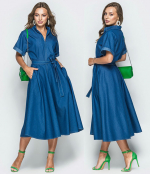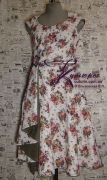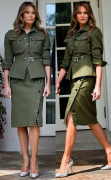Size charts What is the height of the pattern Payment methods Ask a question Reviews
How to sew a beautiful dress with a simple pattern with a one-piece sleeve and a sun skirt with your own hands
Contents of the instruction:
- Pattern description.
- Complete set of an electronic pattern of a dress.
- Description of the kimono shirt dress style design.
- What to sew and how to calculate fabric consumption.
- How to buy, download and print patterns.
- How to cut a dress-shirt on a simple pattern.
- How to sew this dress for beginners step by step.
Buy and download this dress pattern
Pattern Description
 An electronic pattern of a simple shirt dress with a one-piece sleeve and a flared sun skirt.
An electronic pattern of a simple shirt dress with a one-piece sleeve and a flared sun skirt.
Sizes: 40-52 and 52-64.
File Format: PDF full size and without seam allowances
After paying for the order, you will receive links to download two files patterns of a shirt dress with a one-piece sleeve, gradation of sizes from 40 to 52 or from 52 to 64:
- PDF file A4, adapted for printing patterns on sheets of A4 paper in any program on any device, including mobile phones.
- Multi-format PDF file for printing on sheets of any size from A0 to A4 on a printer or plotter using Adobe Reader.
Sewing difficulty level: easy. You will need basic skills in cutting, sewing and fitting.
The style of the dress is suitable for full and slender figures.
The pattern is designed for sewing at home on household sewing machines.
Complete set of electronic dress pattern
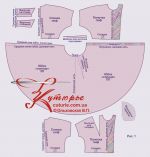 For download three sets of simple patterns are collected - patterns of small sizes, patterns for full ones and patterns with a breast tuck for large breasts for and large sizes. Each set includes (picture 1):
For download three sets of simple patterns are collected - patterns of small sizes, patterns for full ones and patterns with a breast tuck for large breasts for and large sizes. Each set includes (picture 1):
- Bodice patterns - back and shelf.
- Sun skirt pattern.
- Collar patterns - on the stand and turn-down.
- Burlap pattern for processing a pocket.
- Pattern pattern for pocket tuck.
- Skirt tuck template.
Cuff patterns are not included in the pattern package, as cuffs are strips of fabric, rectangles. How to cut cuffs is described below.
The belt pattern is also not included, since the belt is also a strip of fabric. Free pattern belt with curly ends can be downloaded on my site.
There you can download free patch pocket patterns.
Description of kimono shirt dress style design
This one is very simple cut dress a one-piece sleeve of the "kimono" type is complemented by a shirt collar on the stand and a turn-down collar.
The flared "sun" skirt has a modified design that will allow it to deform less during wear due to the oblique middle seam of the skirt.
A one-piece selection will simplify and significantly speed up the processing of the bodice and skirt for novice home couturiers.
 In addition, a one-piece bead will significantly improve the quality of processing and wear resistance of the sides.
In addition, a one-piece bead will significantly improve the quality of processing and wear resistance of the sides.
Separately, it is worth mentioning the tuck for the pocket, which actually replaces the seam. And everyone knows that it is in the side seam that lovers of cutting and sewing today process pockets. However, the location of the pocket in the side seam is inconvenient and its more advantageous position is 5-15 cm ahead of the side seam.
The pocket on the “sun” skirt, which does not have a side seam, can be easily processed in any convenient place by making a cut (picture 3).
The most frequently asked question is about the tuck on the bodice. Why is she needed?
Lovers prefer a bodice without a dart, even in patterns for fuller ones, but a bodice without a dart for the bust often turns out to be unbalanced and gives an unpleasant looseness in the shoulder and chest area.
In one of the sets of this dress pattern, a bodice with a chest tuck is offered, which can be processed like a soft fold by sewing a line only to the middle of the tuck or like a tuck, stitching it to the end.
What to sew and how to calculate fabric consumption
The calculation of the fabric of this simple shirt dress depends only on the length of the skirt you choose.
The consumption formula, as for any other dress with a sun skirt, is as follows:
2 Du + Notch Diameter + 10 cm per backing
In our case, it is enough to choose the length of the skirt (Du), taking a measurement from the waist down the side seam, and measure the length of the skirt pattern from the bottom point, of course, taking into account the chosen length and the selected notch.
Thus, the approximate consumption will be from 350 to 400 cm, depending on the size and length of the dress you choose.
You can sew such a dress both from denim and from fairly dense linen fabric, as well as from poplin.
Fabrics that are strongly stretched along an oblique thread will not work. For example, staple.
How to buy, download and print patterns
How to choose a size without using tables and taking measurements.
What height are the patterns designed for.
How to buy a ready-made electronic pattern.
How to print a pattern at home life-size on A4 sheets or on sheets of any other size.
How to assemble a pattern after printing.
Simple patterns of dresses, sweatshirts, skirts and trousers in full size free download.
Buy and download this dress pattern
How to cut a kimono shirt dress with a sun skirt according to a simple ready-made pattern
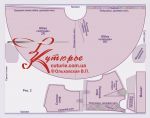 The first difficulty that an inexperienced tailor will face is choosing the size of the skirt.
The first difficulty that an inexperienced tailor will face is choosing the size of the skirt.
What you should pay attention to:
- The length of the recess can be equal to both the half-circumference of the waist (St or Pot), and the length of the waist cut of the bodice, or exceed any of these lengths. In other words, the size of the bodice can be chosen separately from the size of the skirt. What for? To perform gathering or additional pleats on the bottom of the bodice or on the skirt, or to connect them 1:1 - it's up to you. This is also important because the waist section of the sun skirt is subject to strong stretching, and no matter how accurately we choose the size of the notch along the length, it will still not be accurate.
- Half-girth measurements (St) are recorded, like literate people, in half size, because symmetrical patterns are built on half the figure, and symmetrical details are cut out on them on a fabric folded in half.
- When choosing the size of the notch, we DO NOT take into account the width of the skirt selection, that is, what is shaded is no longer the waist.
- After choosing the size of the skirt for the recess, we proceed to the choice of the Length of the skirt (Du) - select the desired line and you can immediately add 2 - 3 cm for the base (alignment) and for processing the bottom.
- The size of the bodice can be chosen both according to the finished product of the same type, and according to the size figure equal to Cg (half-girth of the chest).
- For girls and ladies with large breasts, a bodice with a chest tuck is recommended, which you can process as a soft fold.
Now for the seam allowances
Everything here is easier than it might seempicture 2).
We add allowances to the skirt only along the middle seam and along the hem - 1 cm. For the rest of the cuts (along the notch and along the bottom) - we do not add if we take into account the hem and adjustment.
For the bodice - shoulder, side and cuts of the bottom of the sleeve - 1 cm. Please note that the side cut is no more than 1 cm.
We do not add allowances along the cuts of the neck, that is, at all.
If you use a bodice with a chest tuck, then above the tuck is a “house”.
On the bottom of the bodice for fitting, we add a large allowance - 3 - 4 cm.
cuff
The cuffs, as mentioned above, are a rectangle. The calculation of length and width in cutting is simple.
Cuff length = sleeve length + 2cm
Cuff width = finished cuff width + 2cm
It is more convenient to cut out the cuffs after processing the shoulder seam, but it is also possible together with the rest of the details.
Allowances are not required for the pocket burlap, but if your customer has large hands or you want a larger pocket, you can add 1 cm “in a circle”.
It is advisable to cut out the collar after the fitting and processing of the shoulder sections, so that the length of the neck of the bodice is known exactly.
Allowances - 0,7 for the lower collar and 1 cm for the top. The difference between the width of the allowances will provide an easy processing of the edge.
The layout is shown in 2 drawing. Please note that the fabric is folded in half across.
After cutting, do not forget to put notches, marking them with folds, a half-skid (the middle line of a shelf or skirt in front), a breast tuck or warehouse, if any, and a tuck under the pocket. It is more convenient to mark the tuck under the pocket using a special template.
If you are sewing a dress without pockets, or with patch pockets, then this tuck is not needed.
How to sew this dress for beginners step by step
 Sewing dresses of large sizes of this style is not very difficult, especially if you carefully read all of the above.
Sewing dresses of large sizes of this style is not very difficult, especially if you carefully read all of the above.
The main stumbling blocks in this dress are two points - fitting and pockets.
Let's take a look at an example
As in other dresses cut off at the waist, it is very important that the length of the bodice matches the features of the figure (high chest-short back, small chest-long back, etc.) and the couturier's intentions (with or without an overlap).
For a bodice with a one-piece sleeve, the balance is corrected in this case due to the neckline. For example, for a stooped back, it is worth cutting the neck in front, and for a kinky back, a sprout (neck of the back).
In practice, the bodice must be tied with a linen elastic at the waist to check the balance and length of the bodice, and then, make adjustments and, putting the bodice on the figure again, outline the waist cut.
Only then can the bodice be connected to the skirt and tried on again to even out the bottom of the skirt.
In fact, it turns out three fittings, which can be combined into one if the customer can wait.
Pockets
As for the pockets, their processing is very simple - a cut in the middle of the tuck (picture 3).
Cut length = pocket entry length + 7 or 8 cm.
We apply the burlap of the pocket face to face to the incision, stepping back from the waist along the tuck 6 - 7 cm, stitch, overcast and iron the open sections. Then it remains only to stitch the seam "tuck-burlap-tuck" with its subsequent overcasting.
As you can see, everything is simple.
Sewing sequence step by step for beginners
- Prepare the bodice for fitting - duplicate the shaded area of the selection; overcast the departure cut of the selection; grind the shelf along the half-skid, leaving a fragment of the seam 10 - 14 cm unstitched at the top; iron the sides, bending the shelf along the half-skid; take a selection; sweep the folds with large oblique stitches; stitch, overcast and iron the middle, shoulder and side cuts of the bodice.
- Prepare the skirt for fitting - process the pockets; duplicate selection; bend the allowance of the pick-up and iron it, bend the pick-up and iron it again; stitch the skirt along the half-skid, leaving a fragment of the seam 20 - 30 cm unstitched; take a selection; stitch, overcast and iron the middle seam at the back.
- Fitting.
- Processing the bottom of the skirt into a hem with an open cut - overcast, bend by 0,7 - 1 cm.
- Processing the bottom of the sleeve with cuffs - iron the cuffs in half lengthwise; compare the length of the cuffs with the length of the bottom of the sleeve; stitch, overcast, iron.
- Process the collar; toss and toss.
- Connect the bodice and skirt, distributing them evenly relative to each other. That is, having previously combined only the middle seams of the skirt and bodice in front and behind, and evenly between them. This approach will allow you to easily connect the bodice and skirt, in which the length of the waist sections does not match, which happens in most cases.
- Run the finishing stitches and secure the pick-up, if necessary, with blind stitches or thermoplastic adhesive tape, popularly referred to as "spider line".
- Process the belt.
- So that the belt does not go over the dress, but reliably hides the waist cut, 2-5 lines can be made above the cut line with a rubber thread, wound on a bobbin. You can also stitch only the waist seam allowance.
Download this pattern pdf:
A simple pattern of a shirt dress with a one-piece sleeve and a flared sun skirt
$2.00 (80 hryvnia)
Bank cards of the Russian Federation are not accepted for payment!
Size charts What is the height of the pattern Payment methods Ask a question Reviews
Vera Olkhovskaya in social networks:

See similar clothing patterns and how to sew on them
-
Any pattern for free for a review of a previously made order
More...
Lifetime promotion for buyers of patterns!

Leave a review about my store of patterns for an order that you made before, and you will receive any paid pattern of your choice Free!
